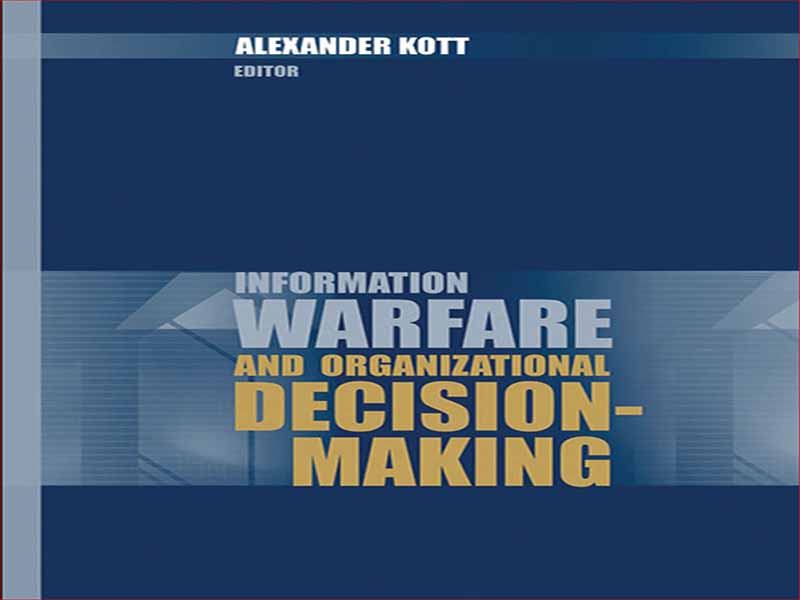- عنوان کتاب: Information Warfare and Organizational Decision-Making
- نویسنده/انتشارات: Alexander Kott
- حوزه: جنگ اطلاعاتی
- سال انتشار: 2007
- تعداد صفحه: 294
- زبان اصلی: انگلیسی
- نوع فایل: pdf
- حجم فایل: 3.31 مگابایت
سازمان ها از با ارزش ترین و در عین حال شکننده ترین ساختارهای تمدن ما هستند. ما برای به دست آوردن اطلاعات، درک و پردازش اطلاعات، جمع آوری و درونی سازی اطلاعات، تصمیم گیری بر اساس بخشی از آن اطلاعات و اجرای آن تصمیمات به سازمان ها متکی هستیم. سازمان ها در همه جا حضور دارند زیرا ضروری هستند. از ابتداییترین تا پیچیدهترین جوامع، سازمانها در انواع مختلف، ستون فقرات تصمیمگیری اجتماعی را تشکیل میدهند. این کتاب به بررسی پیشرفتهای اخیر در راهحلهای محاسباتی برای مشکلات بهرهبرداری یا کاهش آسیبپذیریها در فرآیندهای تصمیمگیری سازمانی میپردازد. طیف وسیعی از تکنیکهای محاسباتی را توصیف میکند که میتواند به هدایت حملات علیه سازمان دشمن یا دفاع از خود کمک کند. از منظر مهندسی، کاربردهای تکنیک های شرح داده شده در این کتاب طیف وسیعی از مسائل عملی را پوشش می دهد. آنها شامل برنامه ریزی و فرماندهی عملیات نظامی علیه یک سازمان فرماندهی دشمن، اطلاعات نظامی و خارجی، ضد تروریسم و امنیت داخلی، امنیت اطلاعات، طراحی سازمانی، روانشناسی و آموزش نظامی، تمرین مدیریت و محاسبات سازمانی است. به طور خاص، یک رشته – جنگ اطلاعات – به طور سنتی توجه ویژه ای به مسائل مربوط به حمله و دفاع از سازمان های فرماندهی نظامی می کرد. رویکردهای محاسباتی قابل استفاده برای چنین مسائلی در چندین رشته علمی سرچشمه می گیرند: نظریه سازمان محاسباتی، علوم سازمانی و مدیریت، برنامه ریزی هوش مصنوعی، مدل سازی شناختی، و نظریه بازی. هدف اصلی این کار نشان دادن روابط نزدیک مهم بین ایده هایی است که از چنین حوزه های متنوعی می آیند. دلایل متعددی وجود دارد که چرا نویسندگان معتقدند کتابی در این زمینه بهویژه در حال حاضر به موقع است. پیش از این، در دهه 1990، محققان به موضوعات مرتبط در زمینه جنگ اطلاعاتی، به ویژه در زیر شاخه جنگ فرماندهی و کنترل [2] و در تکنیک های شبیه سازی سازمان های فرماندهی و کنترل برای بازی جنگی مبتنی بر شبیه سازی جذب شدند. اخیراً، وسعت و عمق تحقیقات مرتبط به طور چشمگیری گسترش یافته است. تعداد نشریات و کنفرانسهای مرتبط با مدلسازی و تحلیل سازمانی در چند سال اخیر رشد چشمگیری داشته است. این رشد خارق العاده عمدتاً به دلیل پیامدهای حمله تروریستی 11 سپتامبر 2001 و توجه ناشی از آن به (1) راه های درک و تأثیرگذاری بر سازمان های تروریستی و شورشی و (2) نگرانی در مورد آسیب پذیری سازمان های داخلی بود. علاقه بیشتر به این موضوعات توسط فرآیندهای تحول عظیم (و پرهزینه) در ارتش ایالات متحده تحریک می شود. این امر با تجدید نظر در رویکردهای سازماندهی ساختارها و فرآیندهای فرماندهی در عصر تسلط اطلاعات و شبکه های فراگیر گسترده همراه است. همچنین با درک تازهای از پیچیدگی، غیرخطی بودن و آسیبپذیری فرآیندهای بسیار پویا که در سازمانهای تصمیمگیر رخ میدهند، همراه است. موارد دستکاری سازمانی در مقیاس بزرگ، مانند انرون و برنامه نفت در برابر غذا سازمان ملل متحد (سازمان ملل متحد) نیز علاقه به ابزارهایی را برای شناسایی و جلوگیری از چنین حملات پیچیده ای به پادمان های سازمانی ایجاد می کند. علاوه بر این، تنها در 5 تا 10 سال گذشته پیشرفت قابل توجهی در روشهای محاسباتی عملی مربوط به درک کمی عملکرد سازمانی حاصل شده است.
Organizations are among the most valuable and yet most fragile structures of our civilization. We rely on organizations to obtain information, to comprehend and process information, to accumulate and internalize information, to make decisions based in part on that information, and to execute those decisions. Organizations are ubiquitous because they are indispensable. From the most primitive to the most complex societies, organizations of various types have constituted the backbone of societal decision-making. This book explores recent developments in computational solutions to problems of exploiting or mitigating vulnerabilities within organizational decision-making processes. It describes a range of computational techniques that can help to guide attacks on an adversary’s organization or the defense of one’s own. From an engineering perspective, the applications of the techniques described in this book cover a broad range of practical problems. They include planning and command of military operations against an enemy command organization, military and foreign intelligence, antiterrorism and domestic security, information security, organizational design, military psychology and training, management practice, and organizational computing. In particular, one discipline—information warfare—traditionally paid special attention to issues related to attacking and defending military command organizations. Computational approaches applicable to such problems originate in several scientific disciplines: computational organization theory, organizational and management sciences, artificial intelligence planning, cognitive modeling, and game theory. A key objective of this work is to demonstrate important close relations between ideas coming from such diverse areas. There are several reasons why the authors believe a book on this topic is particularly timely now. Earlier, in the 1990s, researchers were attracted to related topics in the context of information warfare, particularly in the subfield of command and control warfare [2], and in techniques for simulating command and control organizations for simulation-based wargaming. More recently, the breadth and depth of related research have extended dramatically. The number of publications and conferences related to organizational modeling and analysis has grown by an order of magnitude in the last few years. This phenomenal growth was largely due to the aftermath of the September 11, 2001, terrorist attack and the resulting attention to (1) ways to understand and influence terrorist and insurgent organizations, and (2) concerns about the vulnerability of domestic organizations. Additional interest in these issues is spurred by massive (and expensive) transformational processes in the U.S. military. It is accompanied by the rethinking of approaches to organizing the command structures and processes in the age of information dominance and massive pervasive networking. It is also accompanied by newly heightened appreciation of the complexity, nonlinearity, and vulnerability of the highly dynamic processes that occur in decision-making organizations. Cases of large-scale organizational manipulation, such as Enron and the United Nations (UN) Oil-for-Food program, also engender interest in means to detect and prevent such sophisticated attacks on organizational safeguards. Furthermore, it has been only within the last 5–10 years that significant progress has been made in practical computational methods relevant to quantitative understanding of organizational performance.
این کتاب را میتوانید از لینک زیر بصورت رایگان دانلود کنید:
Download: Information Warfare and Organizational Decision-Making




































نظرات کاربران